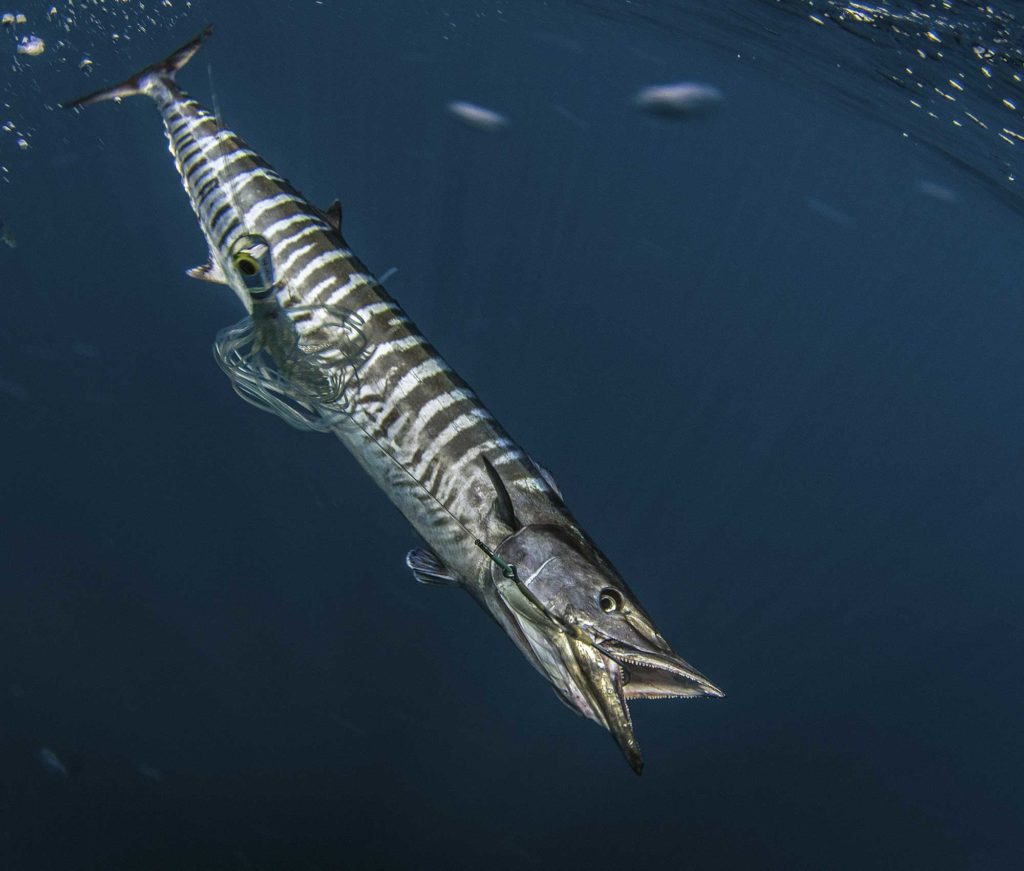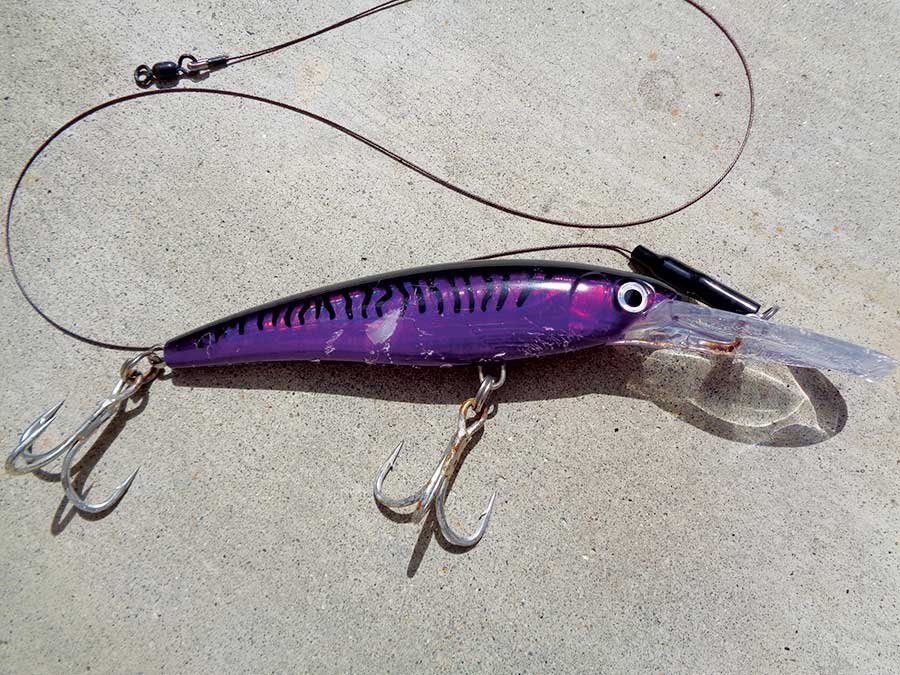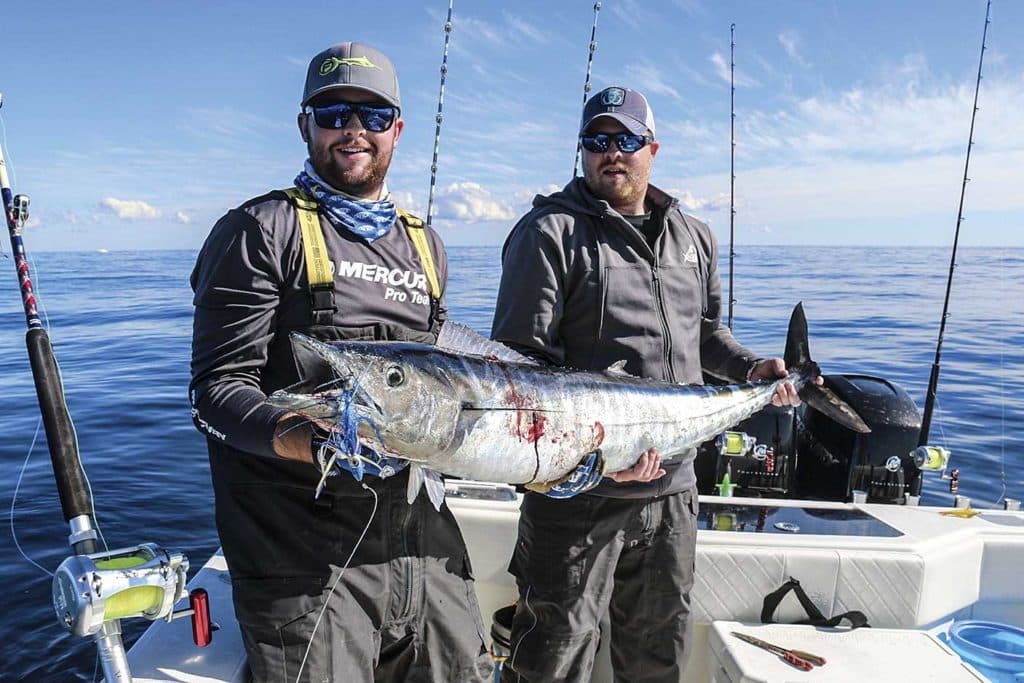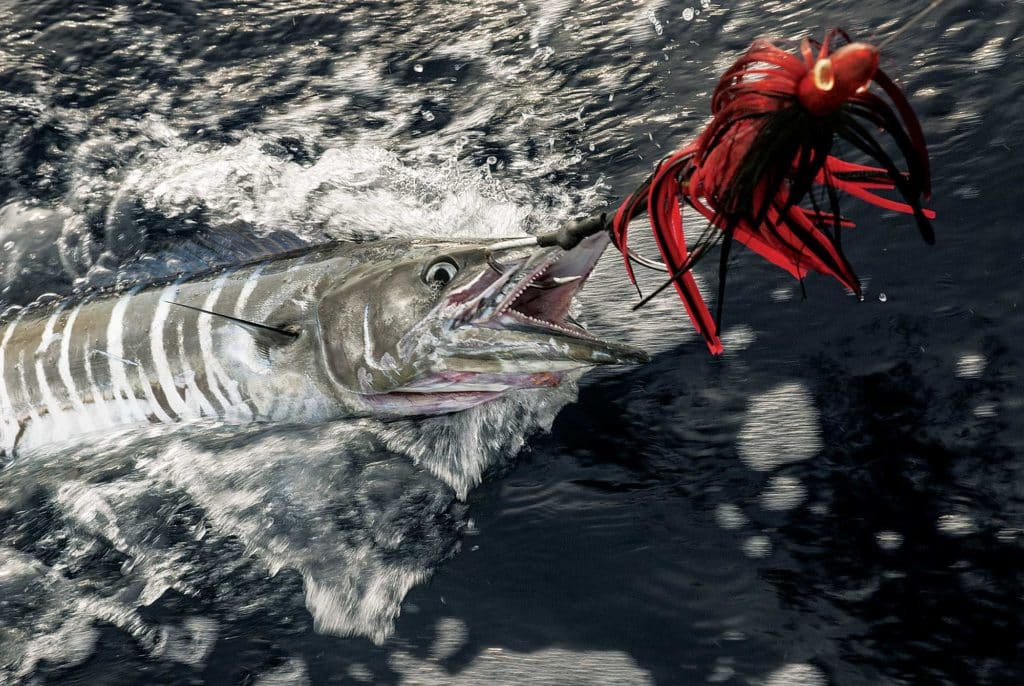
Offshore trollers can be separated into three categories: those who slow-troll, those who troll fast, and those who troll for wahoo. Comparatively speaking, that’s like driving your vehicle through a lunchtime Chick-fil-A parking lot, driving on an interstate, and driving in the Daytona 500.
High-speed trolling for wahoo is faster than ever, in part because of new lures, improved tackle, and faster, more-maneuverable boats. Anglers also have realized that they really can’t troll too fast for wahoo, which rank among the fastest fish in the ocean.
“I usually troll for wahoo at 14 to 17 knots,” says Capt. Cory Burlew (goddesscharters.com) of Deerfield Beach, Florida, who has fished for wahoo for 30 years. “When I first started, we did 8, 9, 10 knots. Thirteen knots was the big number in the late 1990s.”
“We troll from 12 knots up to 16 knots,” says Mark Henderson (fishlf.com), captain of the Liquid Fire Fishing Team out of Cape Carteret, North Carolina, who adds that wahoo can’t help but chase something whizzing by them. “They’re predatory. You get in their strike zone, it’s an instinctive reaction.”

Go-Fast Lures
Henderson, who competes in king mackerel and multispecies tournaments with his sons Joshua and Crockett, said at press time that the wahoo bite off North Carolina had been strong since fall. He commonly heard reports of fish from 50 to 60 pounds, as well as several over 100 pounds.
Henderson’s new boat, a SeaVee 390Z with four Mercury Verado 400 outboards, makes it child’s play for him to run 60 to 65 miles to fish for wahoo in 30 to 50 fathoms. He dials in the fish using his SiriusXM sea-surface temperature data to find breaks, where blackfin tuna, vermilion snapper and flying fish typically congregate—all prey species for wahoo.
“High-speed trolling covers so much ground, it’s becoming more and more popular,” Henderson says. “Yo-Zuri Bonita plugs are pretty popular. The Blue Water Candy Jag-A-Hoo is very popular here. It’s got a blade, so it creates a lot of flash. It’s a little heavier and a little bigger, so it stays a little more in the water. Purple-and-black, black-and-blue or red-and-black—those colors tend to entice strikes.”
Burlew, whose biggest wahoo weighed 110.4 pounds, does most of his high-speed wahoo trolling in the Bahamas and says he has always had luck with those same dark colors for big fish because the baits resemble bonito. He uses his own custom slant-head lures, which he plans to eventually bring to market.
“Most people use straight-running lures. I like slant heads because they run better and deliver more action,” he explains.
Burlew adds that many wahoo-tournament anglers fish Black Bart Lures, such as the 12-inch San Sal Candy or Hawaiian Eyes. His lures are slightly smaller to better match what wahoo eat.
That’s also part of his tournament strategy. In the early days of high-speed wahoo trolling, when Burlew fished on Concrete Machine with Capt. Ron Schatman, the most wahoo won. Now, the biggest wahoo wins.
“The ones we use are the right size that the fish are feeding on,” says Burlew of his lures, which are 8 to 10 inches long. “Sometimes the smaller ones seem to catch more fish and bigger fish because wahoo feed on flying fish and small tuna. I feel like the big fish are lazy. They’d rather eat a small bait. It’s like walking by a buffet; are you going to pick up a french fry or a baked potato?”

High-Speed Tackle
Burlew and Henderson both usually troll five lines: one far behind the boat, one on each outrigger, and one at each corner. The latter four are staggered at different distances because sometimes wahoo prefer lures close to the boat, and sometimes they bite only the distant ones. Starting off with different colors helps the skippers determine what the fish want that day.
“I put out either three brights and two darks or three darks and two brights,” says Burlew, who fishes variations of the same color once he determines which is preferred. “The majority of the time, once you home in on a color, that’s when you get your multiples. Sometimes the fish like bright colors early in the morning. In dark-purple water, dark colors work best. Sometimes I use blue, black and white lures to imitate giant ocean flyers with white backs.”
A member of the Accurate pro staff, Henderson uses ATD TwinDrag 50-wide reels spooled with 50-pound Yo-Zuri Hybrid copolymer line. He’ll top it with 50 feet of 100- or 120-pound Yo-Zuri fluorocarbon, and tie that to a small, stainless-steel ball-bearing snap swivel. Ten to 12 feet of wire goes from the swivel to the lure. “If we have to change lures, we’ll cut down the wire until it gets to 4 or 5 feet. We try to keep baits in the water.”
He pairs the reels with custom 6-foot, 50-pound-class rods with AFTCO guides and bent butts. His anglers fight wahoo either from a swiveling rod holder or an AFTCO stand-up belt.
One of the key innovations since the old days of high-speed trolling is braided line. Burlew says he used to troll either 100-pound wire line or 80-pound monofilament line for wahoo. Although he prefers the stretch, shock absorption, and forgiveness of mono, he says it’s hard to overlook the advantages of braid, which is what he primarily fishes today.
“We can fish the drags a little tighter, and the braid cuts through the water better, so we can fish a little bit lighter lead,” says Burlew, who uses 80- or 130-pound Shimano Tiagra reels because of their strong drags and line capacity. “With monofilament, the farther out it gets, the tighter the drag becomes or the line breaks. With braid, you have the same amount of drag with half a spool. If too much line goes out, it’s easier to gain it back.”

Cable Benefits
Another recent adaptation for Burlew is using cable instead of wire to connect a trolling weight to the main line and to the lure. “What that does is it enables you to go shorter [on the shock cord],” he says. “If a fish hits the lead, it won’t cut you off. I use heavier cable—900-pound—from the snap swivel to the lead, and thinner cable—400 to 480—for the shock cord.
“All of my shock cords are the same length: 35 to 40 feet. When I used wire, my shock cords were 100 feet. Make sure your snap snivels are good. I like 300- to 400-pound snap swivels so strong that it takes Superman to open them up. Wahoo hit so hard sometimes, they’ll almost spring it open.”
Read Next: Louisiana’s Wahoo Wonderland
That’s the nature of this prime gamefish; it can’t help but shift into high gear to chase down a lure that zips past. Moral: The faster you troll, the better the wahoo bite.
West Coast Wahoo
To target wahoo out of Southern California, many anglers book trips on multipassenger long-range boats to fish Mexico’s Baja Peninsula. “Most anglers head south on a seven- or eight-day trip or longer to reach the wahoo areas,” says Steve Carson, a Penn and Rapala pro staffer from Carlsbad, California. “In some warmer years, the wahoo have been a little closer. From 2014 through 2016, Oceanside (California) was ground zero for wahoo.”
Carson says the boats run about 450 miles to a series of volcanic islets, known as Alijos Rocks, and to an area known as the Ridge. Wahoo typically can be found there from July through December, but he adds that the best months to catch the fish are probably September and October.
When fishermen trolling lures hook wahoo from a long-range boat, other anglers cast lures or live bait to the school. Carson says most of these bigger boats troll for wahoo at 9 to 11 knots, “although certainly plenty of fish are caught at 7½ knots.”
About 40 years ago, anglers fished chrome-plated lead-head jigs with feathers that weighed 10 to 16 ounces, he says. In the late 1980s, what Carson calls the pregnant guppy-style plug became popular.
The trolling lures of choice today include the Braid Marauder and the Yo-Zuri Bonita. Carson trolls a black-and-purple Rapala X-Rap Magnum XR40. He rigs the lure with 2 feet of 175-pound cable leader, and fishes it on 80-pound monofilament line spooled to a Penn International 30 or 50. The big reels become necessary if you hook a large tuna or marlin.
Carson upgrades the VMC 4X Perma Steel hooks to 6X to handle wahoo that can range from 30 to 100 pounds. “Anything over 60 pounds is considered big. A fish of 70 pounds will usually win you the jackpot.”
Other popular deep-diving plugs include the Nomad DTX Minnow and Bomber CD 30—the bigger the better. “We get so few opportunities to be in the wahoo area, we don’t want a tuna to bite,” Carson says. “Ten- to 15-pound tuna are just like flies. They’ll drive you insane. Trolling those big plugs is a way to concentrate on the wahoo.”
Favorite colors include orange with a black back or dark purple with a black back, although Carson says, “it’s really more the wiggle than the color. Every boat has one lure that swims the way the fish like it.”
Captains troll lures in the prop wash of the long-range boats, which seem to attract wahoo rather than repel them. “You get to see a bite quite often. That’s really thrilling.”








